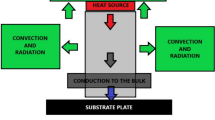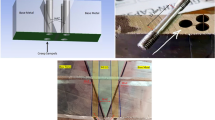Abstract
Arc welding processes with flux-cored wire electrodes are often applied for steel hardfacing. The optimal choice of the process parameters is a key issue for the process stability and the surface quality of the weld seam. However, this complex as a relation between the process characteristics, the predominant mechanisms of the arc, the material transfer, the solidification of the molten pool, the metallurgical properties and therefore the wear behaviour of the weld seam surface is not well studied. Synchronous high-speed imaging with spectral filters and different viewing angles is used for a detailed analysis of the arc attachment at the wire electrode, the wire melting and the behaviour of the weld pool. Two different gas metal arc welding processes, a pulsed process without short circuits and a modified short arc process, and different flux-cored wire electrodes have been used. All the combinations have been studied under different shielding gases: mixtures of Ar with CO2, O2 or He. Macrosections have been used to characterize seam width and dilution. Vickers hardness (HV 0.1) was tested to quantify the hardness of the different phases. The modified short arc processes have turned out to be more stable and go along with a reduced energy transfer to the substrate. As a consequence of the lower energy input, the short arc processes cause a lower dilution but a poor weld seam geometry in comparison with the pulsed processes. The choice of the shielding gas has a significant impact on the melting of the wire and the weld pool behaviour in particular in case of the modified short arc processes. A flatter and regular seam but with more coarse-grained surface structure is obtained with larger admixture of a molecular gas in the shielding gas flow. A semi-empirical approach of the correlation of power input and weld seam geometry demonstrates the potential decrease of the dilution and only smaller changes of the seam form factor by decreasing the electric power of a pulsed process.





















Similar content being viewed by others
References
Vogelpohl G (1950) Die Reibung ausreichend geschmierter Maschinenteile im Hinblick auf eine rationelle Energiewirtschaft. Stahl und Eisen 70:930–936 in German
Richter K, Wiedemeier J (1989) Abrasion-Erosion: Volkswirtschaftliche Bedeutung. In: Kosten und Aspekte zur Kostensenkung. Expert Verlag, Renningen 3:105 in German
Nedeljkovic B, Lazic V, Aleksandrovic S et al (2010) Influence of the carbide type on tribological properties of the hard faced layers. Metall Mater Eng 16(2):77–90. Association of Metallurgical Engineers of Serbia
Schneebeli F, Braun O, Tanner B, Dekumbis R (1993) Method of production of workpieces by welding equipment. U.S. PATENT Sulzer Brothers Limited, Winterthur, Switzerland
Senthilkumar B, Kannan T (2015) Effect of flux cored arc welding process parameters on bead geometry in super duplex stainless steel claddings. Measurement 62:127–136
Hussein NIS, Kamarul SR, Ayof MN (2013) Preliminary study of on cladding process on gray cast iron substrate. IJRET 02/11:5–11
Mendez PF, Barnes N, Bell K, Borle St D, Gajapathi SS, Guest St D, Izadi H, Gol AK, Wood G (2014) Welding processes for wear resistant overlays. J. Manufacturing Processes 16:4–25
Palani PK, Murugan N (2007) Optimization of weld bead geometry for stainless steel claddings deposited by FCAW. J Materials Processing Technol 190:291–299
Liyanage T, Fisher G, Gerlich AP (2010) Influence of alloy chemistry on microstructure and properties in NiCrBSi overlay coatings deposited by plasma transferred arc welding (PTAW). Surface & Coatings Technology 205:759–765
Mendez P (2013) Hardfacing with chromium and tungsten carbide overlays—current state of the art. CWA conference Niagara Falls: 37–29
Schreiber F, Wolfram-Schmelzcarbid im Verschleißschutz: Besonderheiten bei der schweißtechnischen Verarbeitung, www.durmat.com/PDF-Files/d_SLV2000.pdf in German
Bachmann B, Kozakov R, Gött G, Ekkert K, Bachmann J_P, Marques J-L, Schöpp H, Uhrlandt D, Schein J (2013) High-speed three-dimensional plasma temperature determination of axially symmetric free-burning arcs J. Phys D: Appl Phys 46:125203
Theisen W (2004) Walzen aus Pulver, Fachartikel Maschinenbau. Ruhr-University Bochum in German
Landolt-Börnstein (2008) Numerical data and functional relationships in science and technology, group IV physical chemistry 11. Springer, Berlin
Lu L, Soda H, McLean A (2003) Microstructure and mechanical properties of Fe-Cr-C eutectic composites. Mater Sci Eng A 347:214–222
Wang Q, Li X (2010) Effects of Nb, V, and W on microstructure and abrasion resistance of Fe-Cr-C hardfacing alloys. Supplement Welding J:133–139
Ma Y, Li X, Liu Y, Zhou S, Dang X (2013) Microstructure and properties of Ti-Nb-V-Mo- alloyed high chromium cast iron BULL. Mater Sci 36(5):839–844
Streif T (2014) Analyse der Optimierungsmöglichkeiten der Mikrostruktur von FeCrC Legierungen für das MSG-Hartauftrags-chweißen mittels moderner Prozess-varianten, PhD thesis, University Rostock Germany in German
Francis J A (1999) Principles for open arc weld depositions of high chromium white iron surface layers. PhD thesis, University of Adelaide
DuPont JN, Marder AR (1996) Dilution in single pass arc welds. Metallurgical Materials Transactions 27B:481–489
Steinbach I, Schaar H (2016) Calculated with thermocalc using database TCFe, private communication
Richter F (1973) Die wichtigsten physikalischen Eigenschaften von 52 Eisenwerkstoffen. Stahleisen Sonderberichte 8, Düsseldorf, in German
Acknowledgements
The authors thank I. Steinbach and H. Schaar from Ruhr-Universität Bochum for providing data for the melting enthalpy of the deposit and J. Huber for substantial technical assistance in the welding experiments.
Author information
Authors and Affiliations
Corresponding author
Additional information
Recommended for publication by Commission II - Arc Welding and Filler Metals
Rights and permissions
About this article
Cite this article
Wilhelm, G., Gött, G. & Uhrlandt, D. Study of flux-cored arc welding processes for mild steel hardfacing by applying high-speed imaging and a semi-empirical approach. Weld World 61, 901–913 (2017). https://doi.org/10.1007/s40194-017-0485-2
Received:
Accepted:
Published:
Issue Date:
DOI: https://doi.org/10.1007/s40194-017-0485-2




